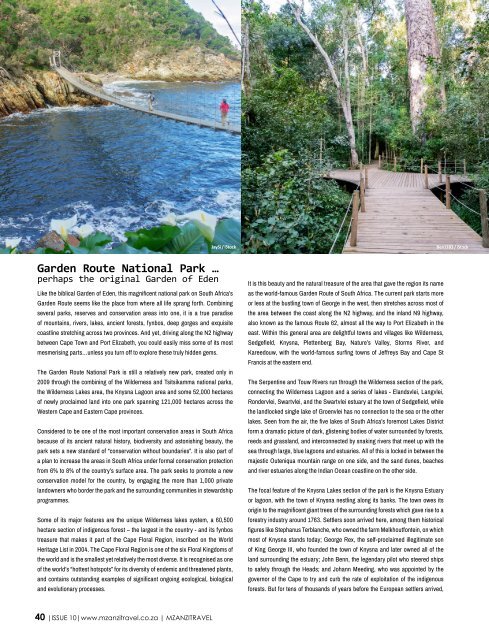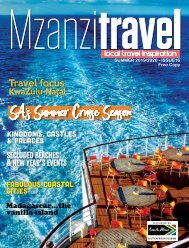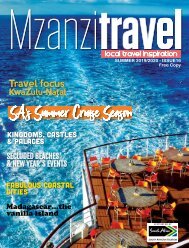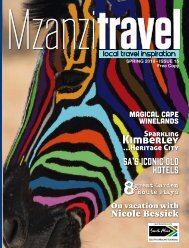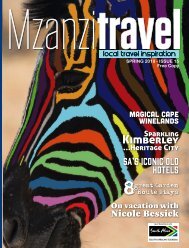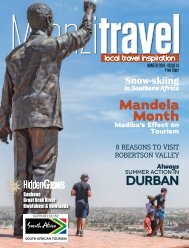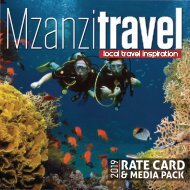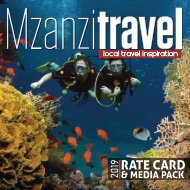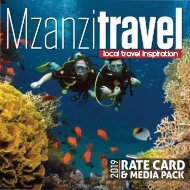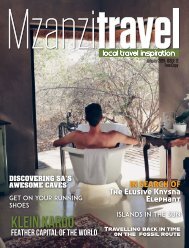You also want an ePaper? Increase the reach of your titles
YUMPU automatically turns print PDFs into web optimized ePapers that Google loves.
JaySi / iStock<br />
Ben1183 / iStock<br />
Garden Route National Park …<br />
perhaps the original Garden of Eden<br />
Like the biblical Garden of Eden, this magnificent national park on South Africa’s<br />
Garden Route seems like the place from where all life sprang forth. Combining<br />
several parks, reserves and conservation areas into one, it is a true paradise<br />
of mountains, rivers, lakes, ancient forests, fynbos, deep gorges and exquisite<br />
coastline stretching across two provinces. And yet, driving along the N2 highway<br />
between Cape Town and Port Elizabeth, you could easily miss some of its most<br />
mesmerising parts…unless you turn off to explore these truly hidden gems.<br />
The Garden Route National Park is still a relatively new park, created only in<br />
2009 through the combining of the Wilderness and Tsitsikamma national parks,<br />
the Wilderness Lakes area, the Knysna Lagoon area and some 52,000 hectares<br />
of newly proclaimed land into one park spanning 121,000 hectares across the<br />
Western Cape and Eastern Cape provinces.<br />
Considered to be one of the most important conservation areas in South Africa<br />
because of its ancient natural history, biodiversity and astonishing beauty, the<br />
park sets a new standard of “conservation without boundaries”. It is also part of<br />
a plan to increase the areas in South Africa under formal conservation protection<br />
from 6% to 8% of the country’s surface area. The park seeks to promote a new<br />
conservation model for the country, by engaging the more than 1,000 private<br />
landowners who border the park and the surrounding communities in stewardship<br />
programmes.<br />
Some of its major features are the unique Wilderness lakes system, a 60,500<br />
hectare section of indigenous forest – the largest in the country - and its fynbos<br />
treasure that makes it part of the Cape Floral Region, inscribed on the World<br />
Heritage List in 2004. The Cape Floral Region is one of the six Floral Kingdoms of<br />
the world and is the smallest yet relatively the most diverse. It is recognised as one<br />
of the world’s “hottest hotspots” for its diversity of endemic and threatened plants,<br />
and contains outstanding examples of significant ongoing ecological, biological<br />
and evolutionary processes.<br />
It is this beauty and the natural treasure of the area that gave the region its name<br />
as the world-famous Garden Route of South Africa. The current park starts more<br />
or less at the bustling town of George in the west, then stretches across most of<br />
the area between the coast along the N2 highway, and the inland N9 highway,<br />
also known as the famous Route 62, almost all the way to Port Elizabeth in the<br />
east. Within this general area are delightful towns and villages like Wilderness,<br />
Sedgefield, Knysna, Plettenberg Bay, Nature’s Valley, Storms River, and<br />
Kareedouw, with the world-famous surfing towns of Jeffreys Bay and Cape St<br />
Francis at the eastern end.<br />
The Serpentine and Touw Rivers run through the Wilderness section of the park,<br />
connecting the Wilderness Lagoon and a series of lakes - Elandsvlei, Langvlei,<br />
Rondervlei, Swartvlei, and the Swartvlei estuary at the town of Sedgefield, while<br />
the landlocked single lake of Groenvlei has no connection to the sea or the other<br />
lakes. Seen from the air, the five lakes of South Africa’s foremost Lakes District<br />
form a dramatic picture of dark, glistening bodies of water surrounded by forests,<br />
reeds and grassland, and interconnected by snaking rivers that meet up with the<br />
sea through large, blue lagoons and estuaries. All of this is locked in between the<br />
majestic Outeniqua mountain range on one side, and the sand dunes, beaches<br />
and river estuaries along the Indian Ocean coastline on the other side.<br />
The focal feature of the Knysna Lakes section of the park is the Knysna Estuary<br />
or lagoon, with the town of Knysna nestling along its banks. The town owes its<br />
origin to the magnificent giant trees of the surrounding forests which gave rise to a<br />
forestry industry around 1763. Settlers soon arrived here, among them historical<br />
figures like Stephanus Terblanche, who owned the farm Melkhoutfontein, on which<br />
most of Knysna stands today; George Rex, the self-proclaimed illegitimate son<br />
of King George III, who founded the town of Knysna and later owned all of the<br />
land surrounding the estuary; John Benn, the legendary pilot who steered ships<br />
to safety through the Heads; and Johann Meeding, who was appointed by the<br />
governor of the Cape to try and curb the rate of exploitation of the indigenous<br />
forests. But for tens of thousands of years before the European settlers arrived,<br />
40 |ISSUE <strong>10</strong>|www.mzanzitravel.co.za | MZANZITRAVEL


